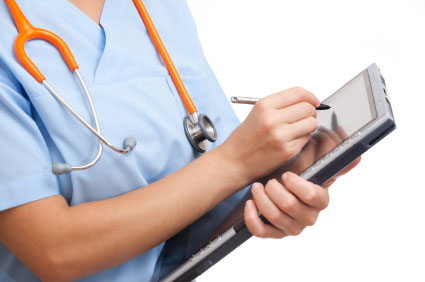The history of mDetailer™
The history of mDetailer™ is comparable in its origins to many other communication technologies. Initially, the life sciences industry demanded a mobile technology to enable drug representatives to provide greater detail in their case studies. Before the explosion of the internet and accessible information, these representatives were the primary source for drug information for HCPs.moPharma

“Electronic details” were designed to give reps a technology solution for product education, communication and demonstration.
HCPs expected something in return for their time with a rep, and detail aids were a useful compromise; reps could discuss the benefits of their product while a physician could learn about the impact of the product in their patient’s lives. Reps found a new prescription channel and physicians had a new prescription option for their practice.
HCPs expect up-to-date information from pharma
Communication didn’t stop at that conversation. New health information, studies, regulatory messages and any other relevant updates about the product were expected to be relayed back to the prescribing HCP as new information became available. Pharma companies were again in need of an effective medium to enable continuous information flow to their users. The solution was found again in new technology – and the many channels becoming available across the internet. At this stage we saw web blogs, RSS feeds, direct mail campaigns, email, brochures and sample honoraria.
Niche markets want to access information at their leisure
Targeted marketing, not mass marketing, became the obvious cost-effective strategy for communicating with the market. While the internet afforded endless opportunities for broadcast messaging, electronic details were smartly being focused on niche healthcare markets and delivering relevant, personalized information to providers.
The tendency to target high-volume prescribing physicians was dropped in favor of the niche markets which were now just as accessible through online channels as any other mainstream market. The model of information delivery was transformed. Physicians had adopted the internet in the workplace and were beginning to enjoy the benefits of information accessibility: in 2008, eighty-four percent of physicians used the Internet and other mobile app development technologies to access pharmaceutical, biotech or medical device information – a twenty percent increase from 2004. Why wait for a rep to return a phone call when relevant prescribing information was at their fingertips? Physicians accessed search engines for clinical treatment information outside of regular office hours, too: 56% on lunch breaks, 70% after work or on weekends, 77% between patient consults and 41% during patient consults.
The industry created tools to enable physicians to access relevant content. With this shift we saw web portals, websites, blogs, journals, and surveys being offered as a means to access prescribing information any time of day.
Rep revival: interactivity enables better conversation between rep and provider
In the market’s most recent shift, evidence shows the trend towards interactive collaboration between HCPs and pharma rep’s new set of tools in mDetailer™ . “physician handling of tablets in meetings makes them more likely to spend more time with the rep, to research further information online, to request samples, and to prescribe the drug discussed.” HCPs find more value from visits with reps when they are able to manipulate the detail aid themselves and actively participate in the conversation. Detail aid creators are naturally responding with more interactive, targeted, accessible features than previous formats carried.
“Tablets clearly enhance details, lengthening rep visits and piquing physician interest in follow-ups, and 54% of mPharma Physicians agree that they make meetings more valuable.”
In this stage of mDetailer™ evolution, “flashy” technology begins to find traction using features like face-to-face video conferencing with key opinion leaders, gesture sentiment tracking, animated video sequences, on-visit report generation, digital leave-behinds, streamed content, etc. Reps curate the flow of new information, listen to the thought process of physicians they visit and react to the content needs as they change.
“Physicians expect to be wowed, and where tablets are merely replacing printed materials, content must be crisp, with intuitive navigation and responsive design.”
The on-site, pre-approved customization of messaging is a prime example of a feature this evolution of interactivity has created. We see regular use of tablet mDetailer™ aids, curated online content by profile, niche market mobile apps, streamed or cloud-based content, and rich media formats for content delivery.
mDetailer™ integrates closed loop marketing
Another mDetailer™ feature is growing quickly: an engine used to capture the preferences and prescribing behaviour of physicians, known in the industry as CLM or closed loop marketing. Suddenly marketers and brand managers have access to an unbelievable level of visibility into their target markets. Responses from actual visits are recorded, tracked, and measured on either a macro or a micro level – whichever layer of granularity a campaign needs.
Current Situation
The wider pharmaceutical industry has slowly begun to introduce apps to the digital marketplace, in particular to assist patient adherence. One notable application in this environment is the app, launched by one of the leaders in the pharmaceutical sector. It has great features, such as giving patients information about their prescription, and the opportunity to set up simple reminders and medication schedules. However, the app is quite poorly designed, with a very basic user interface.
Alongside prescription based medication, also aimed to assist patients in more general health issues, such as giving up smoking, with the opportunity for a digital ‘quit coach’ in your pocket. These ‘light-touch’ applications facilitate user need, without stumbling across strong legislative barriers. Fortunately, these are becoming more common, with a raft of apps of this type now in various app stores across many platforms.
One of the larger challenges to address is the unification of apps across different markets and languages. Many of the apps offered by some of the larger pharma companies are either exclusive to certain markets, or only produced in English, then released to multiple countries. There needs to be a strong strategic direction made when releasing an app to a global market to ensure the broadest benefit to the greatest number of patients.
It's not all good news however, some of the key players in the Pharmaceutical Industry have yet to engage with Mobile Applications as part of their product offering. Bayer Medical for example have three official medical apps according to their company website, these apps are only available for iOS. Each app suffers from poor user interface design, limited international availability and minimal long term support, one of their apps for example was last updated in 2012.
There is a need to adopt digital technologies, by doing so it allows Pharma companies to stay on-trend, embracing and benefitting from the advancements in consumer technology, bridging the gap to patients.
There is a need to adopt digital technologies, it allows Pharma to embrace the advancements in consumer technology, bridging the gap to patients.
Innovation
Aside from the barriers, it is possible to successfully implement apps in this industry. Revolutionary application that could act as a model for the future of healthcare consultations. It completely shifts the perception of the current referral process, by bringing a GP quite literally to your pocket. The app offers patients the chance to book consultations directly with a GP, Nurse, or Specialist Consultant, through video chat or in person. The service is paid for by the user at a relatively low monthly cost, acting as an alternative arm to private healthcare, which could create a real market shift, as it challenges existing providers in the way it approaches the patient journey.
Future
Mobile applications are merely the first step in a long future of technological innovations that will make their way into the healthcare sector. Currently though, the range of pharma apps on the market are still lacking. To deliver the best customer service, a broader number of pharma companies need to engage with the mobile landscape. Additionally, the apps that are out there are either out of date and poorly designed, App. There is a strong need to ensure that an app is designed from a patient perspective, with a clear user interface, and strong user journey. Furthermore, pharma companies need to provide patients with updates to their apps for future mobile OS releases, and updated functionality.
It is early days for the implementation of apps within pharma, but a field that is waiting to be taken advantage of.
Innovation awaits.





Discuss about post